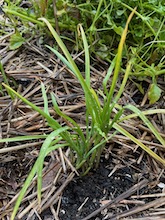Another fine, but cloudy, day brought 22 adults and one child to the garden for the morning.
We harvested silverbeet, celery, asparagus, celtuce, lettuce (Green Cos, Freckles, Rouge d’Hiver, Lollo Rossa, Royal Oakleaf), kale, land cress, radish, parsley, coriander, apple mint, rhubarb and garlic. Our one child today had a lot of fun picking radish for the harvest but her mum told us her daughter doesn’t eat radish because it’s a vegetable (horror!).
In the process of stacking our bunches of various greens this week for people to take home, it turned out that some rhubarb leaves got mixed in with the silverbeet. All parts of the rhubarb plant contain substances known as “oxalates”. Eating plants containing oxalates can cause unpleasant symptoms, which worsen as the amount of oxalates eaten increases. There are higher levels of oxalates in the leaves of rhubarb than the stems. Cooking rhubarb stems makes them edible, but the leaves are not eaten because of the higher levels of oxalates they contain. There is more information about this here:
NSW Department of Primary Industries, Primefact 359, 2006, p. 10
https://www.dpi.nsw.gov.au/__data/assets/pdf_file/0008/112796/garden-plants-poisonous-to-people.pdf
Children’s Health Queensland Hospital and Health Service
https://www.childrens.health.qld.gov.au/poisonous-plant-rhubarb-rheum/
In future, we should keep each type of plant we harvest in a separate pile.
The changeover from our autumn and winter plants to spring and summer plants continues. Much of the silverbeet has started to go to seed and the plants that have started to do this were picked and removed. Lettuce and celtuce were treated the same way.
Recently planted rocket and mizuna were thinned and the extra seedlings put into gaps in suitable beds. Parsley, which until recently was in great supply, is now not so plentiful and was moved to edges of beds. It will come on again soon. Sunflowers were also moved to the corners of beds, where they are most easily managed. We moved spring onions to our dedicated onion bed. We also planted some French marigolds along one side of the tomato bed. French marigolds are a useful companion plant, repelling some pests. The marigold flowers can also be eaten. Thai basil seedlings were planted and saved land cress seeds were sown. We saved mizuna seeds from plants that we had kept to let go to seed.
Jock gave a demonstration of how to prick out individual, small seedlings from a pot containing many small seedlings and transfer each one to a separate, small pot to let it develop to the point where it could be planted out. This is a very common step in the process of propagating plants from seed.
All the garlic we planted early in the year was stolen but Jock discovered that one plant had remained hidden and was missed! With all the recent rain, it has not behaved as proper garlic should (photo below). The tops should have turned brown, signalling that it was ready to harvest. However, this plant has lots of green shoots. These are the result of the recent unseasonable rain leading each of the newly formed garlic cloves to sprout, resulting in “witches broom.” This has been affecting garlic growers around Sydney, as Jock heard reported on ABC radio in a recent Saturday Breakfast show in a segment on gardening (ABC Radio Sydney, Saturday Breakfast, 22nd October 2022, about 41 minutes into the programme https://www.abc.net.au/sydney/programs/saturdaybreakfast/saturday-breakfast/14085862).

